
EN
HU
RO
PL
BG
2. You can measure the blood pressure lying on the back. Look at the ceiling, keep quiet and do not move during
measurement. Be sure that the cuff is placed approximately at the level of your heart.
CUFF PREPARATION (fi g.4)
1. Insert the cuff end for about 5 cm into a metal ring as shown in the fi gure.
2.
Apply the cuff to your left upper arm so that the air tube is directed to your palm. If the measurement on your left
arm is diffi cult, you may use your right arm. In this case remember that the readings may diff er by 5-10 mmHg and
even more.
3. Wrap the cuff around your upper arm so that the bottom of the cuff is approximately 2-3 cm above your elbow. The
sign “ARTERY” should be over the arm artery.
4. Fix the cuff so that it fi ts tightly to the arm, but see that it is not overtight. Too tight or too free placement of the cuff
may give inaccurate readings.
5. On the fi xed cuff the sign «INDEX» should point to the area «NORMAL». It means that the cuff is chosen correctly and
fi ts the size of your upper arm. if the sign points to the area marked
« »
the cuff is too small and the readings will be
higher. If the sign points to the area marked
« »
the cuff is too large and the readings will be lower.
6. If the arm has a conic form, the cuff should be put on with a spiral movement as shown in the fi gure.
7. If the rolled-up sleeve squeezes the arm interfering with free blood fl ow the Device may give inaccurate fi gures not
corresponding to your actual blood pressure.
MEASUREMENT PROCEDURE (fi g.5)
1. Insert the Air Tube Plug into the Cuff Jack. Make 3-5 deep inhales and exhales before taking a measurement and relax.
Do not move, do not speak and do not toughen your arm.
2.
Press
.
3. All symbols will appear on the display screen for a short time, two short sound signals will be given and the Device
will infl ate automatically the air into the cuff . At fi rst the infl ation will stop at the level of 190 mmHg.
4. After reaching the level of 190 mmHg the cuff will gradually defl ate. The fi gures on the screen will count back. The
pulse symbol “
” will start fl ickering.
As the blood pressure and pulse are measured during air defl ation from the arm cuff keep quiet and do not move your
arm and do not toughen your arm muscles.
5. When the measurement is complete the sound signal is given, the arm cuff completely defl ates and your measure-
ment results fl ash on the screen and Indicator «
» will blink, reminding that to retain results, it is necessary to
choose memory 1 or 2, having depressed M1 or M2, respectively. The result may be saved before the beginning of the
next measurement or before turning the device OFF.
If irregular pulse rhythm is detected during measurement, symbol of arrhythmia
“ ” , will appear upon measure-
ment end (for LD23, LD23A). Appearance of arrhythmia indicator may also be caused by body movement during measure-
ment. During periodical appearance of this indication apply to You attending doctor (for LD23, LD23A).
Apart from numerical value of pressure, result is also displayed on scale WHO (Fig. 14). Scale WHO – three-color scale of
classifi cation of received value of arterial pressure, according to recommendation of World Health Organization. The scale is
available from the left.
6. Press – to switch off . For taking a new measurement repeat all steps described in this paragraph.
TO OBTAIN THE ACCURATE RESULT MAKE INTERVAL BETWEEN MEASUREMENTS TO RESTORE THE BLOOD CIRCULA-
TION. WAIT FOR AT LEAST 3 MINUTES BEFORE MAKING A NEW MEASUREMENT.
If the Unit is ON and is unused for 3 minutes it will be switched off automatically.
AUTOMATIC RE-INFLATION
When during the fi rst blood pressure measurement the cuff infl ation to a level of 190 mmHg is not suffi cient or you
move your arm the Device stops measurement and re-infl ates the cuff to the higher level. The Device has 4 fi xed levels
of the arm cuff infl ation: 190, 230, 270 and 300 mmHg.
The automatic re-infl ation is repeated until the measurement is completed successfully. This is not a defect.
FORCED DEFLATION FROM A CUFF
For rapid air release from of the arm cuff during arm cuff infl ation or during a measurement (slow defl ation) press the
button. The arm cuff quickly completely defl ates and the Device is independently switched off .
INFORMATION ABOUT ERRORS
Indication Likely cause Methods of correction
The arm cuff is applied incorrectly or the air
tube plus is inserted not tightly enough.
Measurements cannot be made due to hand
movement or talking during measurements.
At such disorders as deep vascular sclerosis,
weak pulse wave and also in patients with
the prominent distortions of cardiac rhythm
it may be diffi cult to measure the blood
pressure accurately.
Be sure that the arm cuff is applied correctly and
the plug is inserted tightly. Repeat the whole
measurement procedure.
Repeat the measurement following strictly the
recommendations of this Manual.
In such cases consult a certifi ed doctor about
application of the electronic unit.
Batteries are discharged.
Replace the batteries for new ones.
CARE, STORAGE, REPAIR AND DISPOSAL
1. Keep this Device from exposure to higher humidity, direct sunlight, shocks, vibration. THIS DEVICE IS NOT
WATERTIGHT!
2. Do not keep and use this Device near heating installations and open fi re.
3. Remove the batteries if the Device will be unused for a long time. Battery leaking may damage the Device. KEEP
BATTERIES OUT OF REACH OF CHILDREN!
4. Keep the Device clean and protect it from dust. Use the dry soft cloth to clean the Device.
5. Keep the Device and its components away from water, solvents, spirit and petrol.
6. Protect the arm cuff from contacting on sharp things; do not stretch or fold tightly the arm cuff .
7. Do not subject the Device to strong shocks, such as dropping on the fl oor.
8. This Device does not contain special controls to adjust the measurement accuracy. It is prohibited to open
individually the electronic block. Repair the Device only in authorized organizations.
9. On expiration of the warranted service life apply from time to time to authorized repair organizations to check
the technical condition of the Device.
10. Dispose of the Device and its components according to the application local regulations. No special requirements
to disposal of this Device are defi ned by the manufacturer.
11. The arm cuff may withstand multiple sanitary treatments. The internal tissue surface of the arm cuff (contacting
on arm) may be cleaned with cotton ball soaked in 3%-solution of hydrogen peroxide. At long use the partial color
fading of the tissue coating of the arm cuff is possible. Washing and ironing of the arm cuff are not allowed.
TROUBLESHOOTING TIPS
PROBLEM LIKELY CAUSE METHOD OF CORRECTION
After pressing the Button
no indication on the display.
Discharge of batteries.
Polarity of batteries is not observed.
Battery terminals are contaminated
Power source not plugged in an electrical
outlet.
Replace all batteries for new ones.
Install batteries correctly.
Clean the terminals with dry cloth.
Plug the power source into an electrical
outlet.
Infl ation is stopped and
resumed.
Automatic re-infl ation to obtain correct
measurements.
Perhaps you talk or move your arm during
the measurement?
See MEASUREMENT PROCEDURE
Calm down and repeat the measurement.
Every time the blood pressure
is diff erent.
Measurements are too
low/high
Check that the arm cuff is level with
your heart?
Check that the arm cuff is applied
correctly?
Perhaps your arm muscles are tough?
Perhaps you talk or move your arm during
the measurement?
Take the correct position for measu-
rement.
Take the correct position for measu-
rement.
Calm down, apply the arm cuff correctly.
Keep silence and quiet during measu-
rement.
Measurements of the pulse
rate are too high/low..
Perhaps you talk or move your arm during
the measurement?
Perhaps you make measurement directly
after physical load?
Keep silence and quiet during measu-
rement.
Repeat the measurement at least in 5 min.
Impossibility to make a large
of number of measurements.
Application of poor batteries. Use only alkali batteries of well-known
manufacturers.
Spontaneous failure of power
supply.
Actuation of automatic de-energizing
system.
This is not a defect. The Unit is disconnec-
ted automatically in 3 minutes after the
last operation of the Unit.
If regardless of the above recommendation you are unable to get correct measurement results, stop the use of this
Device and apply to a maintenance organization (addresses and telephones of authorized organizations may be
found in the warranty card). Do not try to adjust the internal mechanism by yourself.
WARRANTY
The warranty liabilities are contained in the warranty card given at the sale of this Device to a purchaser.
The addresses of organizations for warranty maintenance are given in the warranty card.
Manufactured under control and for Little Doctor International (S) Pte. Ltd. (35 Selegie Road #09-02 Parklane Shopping
Mall, Singapore 188307, postal address: Yishun Central P.O. Box 9293 Singapore 917699).
Manufacturer: Little Doctor Electronic (Nantong) Co. Ltd. (No. 8, Tongxing Road Economic & Technical Development
Area, 226010 Nantong, Jiangsu, People’s Republic of China).
Distributor in European Union: Little Doctor Europe Sp. z o. o. (57G Zawila Street, 30-390 Kraków, Poland, phone: +48
12 2684746, 12 2684747, fax: +48 12 268 47 53, e-mail: biuro@littledoctor.pl)
For more information please visit www.littledoctor.sg
EN
PARTS AND COMPONENTS (fi g.1)
1
ELECTRONIC UNIT.
8
ELECTRICAL POWER SUPPLY LD-N057 (IT IS
2
LCD.
ATTACHED TO MODIFICATION LD23A AND LD23L).
3
ARM CUFF JACK.
9
(POWER ON/OFF).
4
AIR PLUG.
10
POWER ELEMENTS.
5
AIR TUBE.
11
INSTRUCTION MANUAL.
6
ARM CUFF.
12
WARRANTY CARD.
7
POWER SOURCE JACK.
13
STORAGE CASE.
GENERAL INFORMATION
This Instruction Manual is designed to assist the user with safe and eff ective operation of the automatic digital
Device for measurement of blood pressure and heartbeat rate LD, (modifi cation LD23, LD23A, LD23L) (hereinafter
– the “Device”). Use this Device according to the rules described in this Manual. Operate the Device only as
intended. Do not use the Device for any other purposes. Read and understand the whole Instruction Manual, in
particular “Recommendations on Correct Measurement”.
INDICATIONS FOR USE
Use this Device to measure your systolic and diastolic blood pressure and heartbeat rate in patients aged from 15.
This Device is recommended for use by persons with unstable blood pressure or known arterial hypertension at
home as an addition to medical surveillance.
OPERATION PRINCIPLE
This Device uses the oscillometric method of blood pressure with Fuzzy Algorithm and pulse rate measurement.
Wrap the cuff around your upper arm and it starts to be infl ated automatically. The sensitive element of the
Device feels the weak pressure oscillations in the cuff generated by widening and contraction of the brachial
artery in response to every heartbeat. Pumping in is ceased when cuff is adequately pumped in to determine
diastolic and systolic pressure (the amplitude of the pressure waves is measured, converted into millimeters Hg
and shown on the display as fi gures) after which air is released from cuff . Remember that the Device will not
maintain the mentioned accuracy of a measurement if it is used or stored at a temperature or humidity other
than those specifi ed in Technical Specifi cations of this Manual. We are warning about possibility of mistakes in
blood pressure measurement with this Device in persons with pronounced cardiac arrhythmia. Consult the doctor
concerning blood pressure measurement of your child.
TECHNICAL SPECIFICATIONS
Storage and transportation conditions
Temperature, °C
Relative humidity, % Rh
from -20 to 50
85 and lower
Date and time
yes
Max power intake, W
3,6
ADAPTER LD-N057 ( (it is attached to modifi cation LD23A
and LD23L)
Output voltage
Max load current
Input voltage
Dimensions
Weight
Plug:
Polarity of terminals
Internal diameter, mm
External diameter, mm
Length of plug contact, mm
6 V ± 5%
not less than 600 mA
~200-240 V, 50/60 Hz
64 x 70 x 43 mm
not more 0,3 kg
«–» internal
2.1 ± 0.1
5.5 ± 0.1
10 ± 0.5
Dimensions
Size (electronic block), mm
Weight (without package, case,
batteries and adapter), g
129 x 68 x 54
328 (LD23, LD23A) / 358 (LD23L)
Year of manufacture
Year the manufacture is given in
the bottom of the unit body in a
serial number after symbols “AA”
Opisanie symboli
Type BF
Important: Read the
instructions
Type II
Measurement
method
oscillometric with Fuzzy
Algorithm
Display LCD
Pressure indication
range in an arm cuff ,
mmHg
from 0 to 300
Measurement range:
pressure in an arm
cuff , mmHg
pulse rate, 1/min
from 40 to 260
from 40 to 160
Range of admis-
sible absolute error
at measurement of
air pressure in an arm
cuff , mmHg
±3
Range of admissible
relative error at pulse
rate measurement, %
±5
Infl ation
automatic (air pump)
Defl ation automatic
Type of power supply: 4 “AA” size batteries (LR6) or
adapter not less than 600 mA
Operation conditions
Temperature, °C
Relative humidity,
% Rh
from 10 to 40
85 and lower
Revision date of the present Manual is indicated on the last page as EXXX/YYMM/NN, where YY is the year, MM is the
month and NN is the number of revision. Technical characteristics may be changed without preliminary notifi cation to
improve the operation and quality of the product.
This Device manufacturing is certifi ed according to international standard ISO 13485. Units LD23, LD23A, LD23L
comply with the requirements of European Directive MDD 93/42/ЕЕС, international standards, EN980.
Power source LD-N057 complies with international standard EN 55022 Class A, protection level against electric
shock: Class II, Type BF.
RECOMMENDATIONS ON CORRECT MEASUREMENTS
1.For correct measurement you should know that THE BLOOD PRESSURE IS SUBJECT TO SHARP VARIATIONS EVEN
WITHIN THE SHORT TIME INTERVALS. The blood pressure depends on many factors. It is usually lower in summer
and higher in winter. The blood pressure varies together with the atmospheric pressure, depends on physical loads,
emotional excitement, stresses and dietary regime. Drugs, drinking alcohol and smoking produce signifi cant eff ect.
Even the very procedure of blood pressure measurement in a polyclinic sends the blood pressure high in many
people, thus, the blood pressure measured at home often diff ers from the values received in a polyclinic. As the
blood pressure tends to rise at low temperatures, make measurements at an indoor temperature (approximately
20° C). If this Device stayed under a low temperature, keep it for at least 1 hour at an indoor temperature before
use, otherwise the measurement result may be incorrect. During a day the diff erence in readings for healthy people
may be 30-50 mmHg of systolic pressure and to 10 mmHg of diastolic pressure. The dependence of the blood
pressure on various factors is individual for each person. Accordingly, it is recommended to keep a special book with
blood pressure records. ONLY A CERTIFIED DOCTOR USING YOUR RECORDS IS CAPABLE TO ANALYZE THE TENDENCY OF
YOUR BLOOD PRESSURE VARIATIONS.
2. At cardiovascular and some other diseases requiring blood pressure monitoring make measurements in the hours
fi xed by your attending doctor. REMEMBER THAT THE DIAGNOSTIC AND ANY TREATMENT OF HYPERTENSION MAY BE
CONDUCTED ONLY BY A CERTIFIED DOCTOR ON THE BASIS OF BLOOD PRESSURE VALUES OBTAINED BY THIS DOCTOR.
TAKING OF DRUGS AND THEIR DOSES SHOULD BE PRESCRIBED ONLY BY YOUR ATTENDING DOCTOR.
3. At such disorders as deep vascular sclerosis, weak pulse wave and also in patients with the prominent distortions
of cardiac rhythm it may be diffi cult to measure the blood pressure accurately. IN SUCH CASES CONSULT A CERTIFIED
DOCTOR ABOUT APPLICATION OF THE ELECTRONIC DEVICE.
4. KEEP QUIET DURING A MEASUREMENT TO OBTAIN THE ACCURATE VALUES OF YOUR BLOOD PRESSURE WITH
THE ELECTRONIC DEVICE. Measure your blood pressure in the calm and comfortable conditions at the indoor
temperature. No eating an hour before measurement; no smoking, taking tonic agents, alcohol 1.5-2 hours before
measurement.
5. The accuracy of blood pressure measurement depends on whether the cuff matches the size of your arm. THE CUFF
SHOULD NOT BE TOO SMALL OR TOO LARGE.
6. Wait 3 minutes between measurements for the blood to restore its circulation. However, the persons with
prominent atherosclerosis due to considerable loss of vascular elasticity may need to increase the wait time
between measurements (10-15 minutes). This also refers to the patients suff ering for long from diabetes. For more
accurate determination of blood pressure it is recommended to make a series of 3 consecutive measurements and
to use the average value.
POWER SUPPLY OF THE DEVICE
BATTERY INSTALLATION (fi g.2)
1. Open the cover of the battery compartment and install 4 “AA” size batteries according to polarity marked
inside the compartment. Do not use much force to remove the cover of the battery compartment.
2. Close the battery cover.
The batteries supplied with the Device are intended for check of the Device performance at sale and their service life
may be shorter than of the recommended batteries.
• Replace all batteries when the Low Battery Indicator “ ”, appears on the screen or when there is no any
indication on the screen. The Low Battery Indicator does not show the discharge level.
•Replace all four batteries at the same time. Do not use the waste batteries.
• If the Device is unused for a long time, remove all batteries.
• Do not leave the waste batteries in the Device.
USE OF THE DEVICE WITH THE POWER SOURCE
The jack for connection of the power source is on the right side of the Unit.
Use the power source only with the following technical characteristics:
The output voltage : 6V ± 5%
Maximum output current : not less than 600 mA
Plug:
Terminal polarities : “minus” – internal
External diameter : 5,5 ± 0,1 mm
Internal diameter : 2,1 ± 0,1 mm
Length : 10 ± 0,3 mm
The manufacturer recommends application of the stabilized power source LD-N057 (it is attached to modifi cation
LD23A and LD23L).
When the Unit is used with the power source for a long time, remove all batteries.
CORRECT POSITION DURING MEASUREMENT
(fi g.3)
1. Sit at a table so that during blood pressure measurement your hand rests on its surface. Be sure that the cuff is
placed approximately at the level of your heart and that your arm lies freely on the table and does not move.
LD23, LD23A, LD23L
PL
INSTRUCTION MANUAL FOR DIGITAL BLOOD PRESSURE MONITOR LD23, LD23A, LD23L
BGINSTRUKCJA OBSŁUGI CIŚNIENIOMIERZA CYFROWEGO
LD23, LD23A, LD23L
CZHASZNÁLATI ÚTMUTATÓ.
LD23, LD23A, LD23L
készülék a vérnyomás és pulzusszám
digitális mérésére
HUMANUAL DE UTILIZARE A TENSIOMETRULUI DIGITAL
LD23, LD23A, LD23L
ROРЪКОВОДСТВО ЗА ЕКСПЛОАТАЦИЯ НА ЦИФРОВ ТОНОМЕТЪР
LD23, LD23A, LD23L
fi g.1 rys. 1 1 . ábra desenul 1 рис. 1
PARTS AND COMPONENTS DENUMIREA PĂRŢILOR ȘI COMPONENTELOR
PODSTAWOWE CZĘŚCI I KOMPONENTY НАЗВАНИЯ НА ЧАСТИ И КОМПОНЕНТИ
ALKATRÉSZEK MEGNEVEZÉSE
fi g.2 rys. 2 2 . ábra desenul 2 рис. 2
BATTERY INSTALLATION INSTALAREA BATERIILOR
WYMIANA BATERII
ПОСТАВЯНЕ НА ЕЛЕМЕНТИТЕ НА ЗАХРАНВАНЕ
AZ ELEMEK BEHELYEZÉSE
fi g.3 rys. 3 3. ábra desenul 3 рис. 3
CORRECT POSITION DURING MEASUREMENT
PRZYJĘCIE POZYCJI UMOŻLIWIAJĄCEJ POMIAR
A HELYES TESTHELYZET A MÉRÉSNÉL
POZIŢIA CORECTĂ ÎN TIMPUL PROCESULUI DE MĂSURARE
ПРАВИЛНА ПОЗА ПРИ ИЗМЕРВАНЕ
fi g.4 rys. 4 4 . ábra desenul 4 рис. 4
CUFF PREPARATION PREGĂTIREA MANȘETEI
ZAKŁADANIE MANKIETU ПОДГОТОВКА НА МАНШЕТА
A MANDZSETTA ELŐKÉSZÍTÉSE
2~3cm
fi g.5 rys. 5 5 . ábra desenul 5 рис. 5
MEASUREMENT PROCEDURE ORDINEA MĂSURĂRII
PROCEDURA POMIARU НАЧИН НА ИЗМЕРВАНЕ
A MÉRÉS MÓDSZERE
PL
PODSTAWOWE CZĘŚCI I KOMPONENTY (rys.1)
1
BLOK ELEKTRONICZNY URZĄDZENIA.
8
ZASILACZ LD-N057(W KOMPLECIE DO
2
WYŚWIETLACZ LCD.
MODELU LD23A i LD23L).
3
GNIAZDO DO PODŁĄCZENIA MANKIETU.
9
PRZYCISK (WŁĄCZNIK/WYŁĄCZNIK ZASILANIA).
4
ZŁĄCZE DO MANKIETU.
10
BATERIE.
5
WĘŻYK MANKIETU.
11
INSTRUKCJA OBSŁUGI.
6
MANKIET.
12
KARTA GWARANCYJNA.
7
GNIAZDO DO PODŁĄCZENIA ZASILACZA.
13
TORBA.
INFORMACJA OGÓLNA
Niniejsza instrukcja ma służyć użytkownikom pomocą w bezpiecznym i efektywnym posługiwaniu się automa-
tycznym elektronicznym urządzeniem do pomiaru ciśnienia tętniczego krwi i pulsu LD, model LD23, LD23A, LD23L
(dalej w tekście: URZĄDZENIE). Urządzenie powinno być stosowane zgodnie z zasadami przedstawionymi w
niniejszej instrukcji i nie należy wykorzystywać go do celów innych, niż tu opisane. Należy przeczytać i zrozumieć
całą instrukcję obsługi, zwłaszcza rozdział “Zalecenia dotyczące prawidłowego pomiaru”.
WSKAZANIA DO STOSOWANIA
Urządzenie przeznaczone jest do pomiaru skurczowego i rozkurczowego ciśnienia tętniczego krwi oraz pulsu u
pacjentów w wieku od 15 lat. Ciśnieniomierz zalecany jest do stosowania u pacjentów z niestabilnym ciśnieniem
tętniczym krwi lub nadciśnieniem tętniczym w warunkach domowych jako uzupełnienie nadzoru lekarskiego.
Mankiet dostosowany jest do ramion o obwodzie 25-36 cm.
ZASADA DZIAŁANIA
Urządzenie wykorzystuje oscylometryczną metodę pomiaru ciśnienia tętniczego krwi. Mankiet jest owijany wokół
ramienia i pompowany automatycznie. Czujnik wychwytuje delikatne wahania zmiany ciśnienia w mankiecie,
powodowane rozszerzaniem i kurczeniem się tętnicy ramiennej odpowiednio do bicia serca. Mierzona amplituda fal
ciśnienia przekładana jest na wartość wysokości słupka rtęci, wyświetlaną na wyświetlaczu LCD. Należy pamiętać,
że aby urządzenie wyświetlało poprawne wyniki, musi ono być przechowywane i wykorzystywane w tempe-
raturach i przy wilgotności, nie odbiegających od opisanych w dziale ”Specyfi kacja techniczna” danej instrukcji.
Uprzedzamy o możliwości przekłamania pomiarów u osób z rozrusznikami serca, arytmią serca, zwężeniem naczyń,
zaburzeniami wątroby i cukrzycą. Przed pomiarem ciśnienia u dzieci wskazane jest skonsultowanie się z lekarzem.
SPECYFIKACJA TECHNICZNA
Warunki przechowywania i transportu
temperatura, °C
wilgotność względna, Rh
od -20 do 50
85 i mniej
Maksymalny pobór mocy, V
3,6
Zasilacz: LD-N057 (w komplecie do LD23A, LD23L)
Napięcie wyjściowe
Maksymalny prąd obciążenia
Napięcie wejściowe
Wymiary gabarytowe
Waga
Wtyczka:
biegunowość
średnica wewnętrzna, mm
średnica zewnętrzna, mm
długość, mm
6 V ± 5%
nie mniej niż 600 mA
~200-240 V, 50/60 Hz
64 x 70 x 43 mm
nie więcej niż 0,3 kg
«–» wewnętrzny
2.1 ± 0.1
5.5 ± 0.1
10 ± 0.5
Wymiary
wymiary (korpus), mm
waga (bez opakowania, torby,
baterii i zasilacza), g
129 x 68 x 54
328 (LD23, LD23A) / 358 (LD23L)
Rok produkcji
podany na obudowie w dolnej
części korpusu urządzenia w
jego numerze seryjnym, po
symbolu «AA».
Opisanie symboli
Urządzenie typu BF
Uwaga! Należy zapoznać
się z instrukcją
Klasa ochronna II
Metoda pomiaru oscylometryczna z Fuzzy
Algorithm
Wyświetlacz trzyliniowy wyświetlacz LCD
Zakres wyświetlania
3-300 mmHg (ciśnienie w
mankiecie)
Zakres pomiaru
ciśnienia w mankie-
cie, mmHg
częstotliwości pulsu,
1/min
od 40 do 260
od 40 do 160
Granica błędu pomiaru
ciśnienia powietrza w
mankiecie kompre-
syjnym, mmHg
±3
Granica błędu po-
miaru częstotliwości
pulsu, %
±5
Pompowanie
automatyczne (pompa
powietrzna)
Spuszczanie powietr-
za podczas pomiaru automatyczne
Typ zasilania
elektrycznego:
4 baterie AA (LR6) lub zasilacz,
nie mniej niż 600 mA
Warunki eksploatacji urządzenia
temperatura, °C
wilgotność względna,
% Rh
od 10 do 40
85 i mniej
W celu poprawy poziomu wydajności i jakości urządzenia jego dane techniczne mogą ulec zmianie bez wcześniej-
szego zawiadomienia o tym.
Produkcja urządzeń certyfi kowana jest według międzynarodowego standardu ISO 13485. Urządzenia spełniają
wymagania Dyrektywy Rady MDD 93/42/EEC, standardów międzynarodowych, EN980, EN1041, EN1060-1,
EN1060-3, EN10601-1-2, ISO 14971.
Zasilacz LD-N057 odpowiada międzynarodowemu standardowi EN 55022 Class A, typ i stopień ochrony przed
porażeniem prądem elektrycznym: klasa II, typ BF.
ZALECENIA DOTYCZĄCE PRAWIDŁOWEGO POMIARU
1. Dla przeprowadzenia prawidłowego pomiaru należy pamiętać, że CIŚNIENIE TĘTNICZE PODLEGA SILNYM WAHA-
NIOM NAWET W KRÓTKIM PRZEDZIALE CZASOWYM. Wartość ciśnienia tętniczego krwi zależy od wielu czynników.
Zwykle jest ona niższa w okresie letnim i wyższa w okresie zimowym. Ciśnienie krwi zależy od ciśnienia atmosfe-
rycznego, wysiłku fi zycznego, pobudliwości, stresu, diety. Duży wpływ mają używki; narkotyki, alkohol i palenie
tytoniu. U wielu osób samo przeprowadzenie pomiaru ciśnienia w przychodni wywołuje podniesienie wskaźników.
Z tego powodu wyniki pomiarów ciśnienia tętniczego przeprowadzonych w warunkach domowych często różnią się
od wyników pomiarów, przeprowadzonych w ośrodkach medycznych.
Z uwagi na fakt, że ciśnienie w niskiej temperaturze podwyższa się, należy je mierzyć w temperaturze pokojowej
(około 20°C). W przypadku, gdy urządzenie było przechowywane w niskiej temperaturze, przed użyciem trzeba je
przynajmniej przez godzinę przetrzymać w temperaturze pokojowej, inaczej wyniki pomiaru mogą być przekła-
mane. W ciągu doby wahania ciśnienia u zdrowych ludzi mogą wynieść 30-50mmHg dla ciśnienia skurczowego
(górnego) i do 10 mmHg dla ciśnienia rozkurczowego (dolnego). Wahania ciśnienia u różnych ludzi mogą mieć
różne podstawy, dlatego zaleca się prowadzenie dziennika pomiarów. TYLKO LEKARZ NA PODSTAWIE DANYCH Z
TAKIEGO DZIENNIKA MOŻE PRZEANALIZOWAĆ TENDENCJE ZMIAN I STWIERDZIĆ EWENTUALNE PRZYCZYNY ZABURZEŃ
CIŚNIENIA TĘTNICZEGO.
2. W chorobach układu krążenia, jak i wielu innych, które wymagają monitorowania ciśnienia tętniczego, ważne jest
dokonywanie pomiarów w porach zaleconych przez lekarza. PAMIĘTAJ, ŻE DIAGNOSTYKA I JAKIEKOLWIEK LECZENIE
NADCIŚNIENIA TĘTNICZEGO MOGĄ BYĆ PRZEPROWADZANE TYLKO PRZEZ LEKARZA NA PODSTAWIE WSKAŹNIKÓW
NADCIŚNIENIA TĘTNICZEGO, UZYSKANYCH BEZPOŚREDNIO PRZEZ LEKARZA. PRZYJMOWANIE LEKÓW I ZMIANY W ICH
DOZOWANIU NALEŻY UPRZEDNIO SKONSULTOWAĆ Z LEKARZEM.
3. Przy zaburzeniach takich jak: miażdżyca naczyń krwionośnych, słaby puls, a także u pacjentów z poważnymi
zaburzeniami rytmu serca pomiar ciśnienia tętniczego może być utrudniony. W TAKICH PRZYPADKACH NALEŻY
SKONSULTOWAĆ SIĘ Z LEKARZEM W CELU OKREŚLENIA NAJLEPSZEJ METODY POMIARU.
4. ABY OTRZYMYWAĆ POPRAWNE WYNIKI POMIARU CIŚNIENIA TĘTNICZEGO PODCZAS PRZEPROWADZENIA POMIARU
NALEŻY ZACHOWYWAĆ CISZĘ. Pomiar ciśnienia tętniczego powinien być przeprowadzony w pozycji wygodnej dla pa-
cjenta, w temperaturze pokojowej. Na godzinę przed pomiarem nie należy spożywać posiłków, od półtorej do dwóch
godzin nie spożywać napojów gazowanych i alkoholu, w tym czasie należy również zrezygnować z palenia tytoniu.
5. Dokładność pomiaru ciśnienia tętniczego zależy również od prawidłowego dobrania mankietu do rozmiaru ramienia
oraz prawidłowego ułożenia mankietu. MANKIET NIE MOŻE BYĆ ZA MAŁY LUB ZA DUŻY.
6. Powtórzenie pomiaru jest możliwe po upływie około 3 min. Po takim czasie powraca normalne krążenie w
ramieniu. W przypadku osób z miażdżycą i innymi chorobami układu krążenia czas ten powinien być dłuższy, nawet
do 10-15 min. Dotyczy to również pacjentów z cukrzycą. Określenie dokładnego ciśnienia tętniczego krwi zaleca się
na podstawie dokonania 3 pomiarów i wyciągnięcia średniej z uzyskanych wyników
.
ZASILANIE ELEKTRYCZNE URZĄDZENIA
WYMIANA BATERII (rys.2)
1. Otwórz pokrywę i włóż 4 baterie typu AA zgodnie ze schematem, zamieszczonym w wewnętrznej części
komory. Upewnij się, że została zachowana właściwa biegunowość. Nie stosuj nadmiernej siły podczas otwierania
pokrywy komory.
2. Zamknij pokrywę komory baterii.
Baterie dostarczone z urządzeniem służą do testowania poprawności działania ciśnieniomierza, ich żywotność jest
zatem o wiele niższa, niż żywotność nowych baterii.
• Zamień wszystkie baterie, kiedy na wyświetlaczu ciągle wyświetla się symbol wymiany baterii “ ”, lub nie
wyświetla się nic. Symbol wymiany baterii nie wskazuje poziomu naładowania.
• Podczas wymiany baterii należy zmienić je wszystkie, nie należy zakładać baterii używanych.
• Jeżeli urządzenie nie jest używane przez dłuższy czas, należy wyjąć z niego baterie.
• Nie zostawiaj zużytych baterii w urządzeniu.
STOSOWANIE URZĄDZENIA ZASILANEGO ZASILACZEM
Gniazdo do podłączenia zasilacza znajduje się na prawym boku korpusu urządzenia.
Należy korzystać tylko z zasilacza, który odpowiada poniższej charakterystyce:
Napięcie wyjściowe
: 6V ± 5%
Prąd obciążenia : nie mniej
600
mA
Wtyczka
:
Biegunowość
: “
minus
” –
wewnętrzny kontakt
Średnica zewnętrzna
: 5,5 ± 0,1
mm
Średnica wewnętrzna
: 2,1 ± 0,1
mm
Długość
: 10 ± 0,3
mm
Producent zaleca wykorzystanie zasilacza stabilizowanego LD-N057 (dołączony do zestawu modelu LD23A , LD23L).
Przy korzystaniu z urządzenia zasilanego zasilaczem przez dłuższy czas, baterie należy wyciągnąć z komory.
PRZYJĘCIE POZYCJI UMOŻLIWIAJĄCEJ POMIAR
(rys.3)
1. Usiądź przy stole tak, aby w trakcie dokonywania pomiaru twoja ręka leżała na jego powierzchni. Upewnij się, że
mankiet po założeniu na ramię jest na wysokości serca, a przedramię swobodnie leży na stole i nie porusza się.
2. Pomiaru można dokonywać również w pozycji leżącej na plecach. Podczas pomiaru trzeba patrzeć do góry, zacho-
wywać spokój i nie poruszać się. Należy pamiętać, aby mankiet był założony na ramieniu na wysokości serca.
ZAKŁADANIE MANKIETU (rys.4)
1. Rozsuń mankiet tak, aby metalowy pierścień znajdował się około 5 cm od rzepu, jak pokazano na rysunku nr 1.
2. Wsuń lewe ramię w mankiet tak, aby rurka była skierowana w kierunku dłoni. Jeżeli pomiar na lewej ręce jest utrudnio-
ny, można dokonać go na prawej. Należy pamiętać, że wynik może się różnić o 5-10 mmHg.
3. Owiń mankiet tak, aby jego dolna krawędź znajdowała się w odległości 2-3 cm od łokcia. Rurka i napis «ARTERY»
(TĘTNICA) powinny znajdować się nad tętnicą, od wewnętrznej strony stawu łokciowego.
4. Należy zabezpieczyć mankiet rzepem tak, aby leżał wygodnie i nie był za ciasny. Zbyt ciasne lub luźne założenie
mankietu może być przyczyną błędnych pomiarów.
5. Strzałka INDEX powinna wskazywać na napis NORMAL. Oznacza to, że mankiet jest właściwy dla tej grubości
ramienia. Jeżeli strzałka wskazuje na obszar
« »
na lewo od napisu, znaczy to że mankiet jest za mały i wyniki
będą zawyżone. Jeżeli strzałka wskazuje na obszar
« »
na prawo od napisu, oznacza to, że mankiet jest za duży i
wyniki będą zaniżone.
6. W przypadku dużej objętości ręki zwężającej się stożkowo w kierunku łokcia, mankiet należy nawinąć spiralnie.
7. Zbyt mocno zwinięty rękaw nad mankietem może powodować ucisk, tamując tym samym przepływ krwi, co może
być przyczyną błędnego pomiaru ciśnienia.
PROCEDURA POMIARU (rys.5)
1. Podłącz złącze mankietu do właściwego gniazda ciśnieniomierza. Przed pomiarem rozluźnij się i weź 3-5 głębokich
oddechów. Nie poruszaj się, nie naprężaj ręki i nic nie mów w czasie pomiaru.
2. Naciśnij przycisk
.
3. Przez moment na wyświetlaczu zostaną podświetlone wszystkie znaki (rys. 31), usłyszysz dwa krótkie sygnały, a
urządzenie automatycznie zacznie pompować mankiet. Pierwsze pompowanie mankietu zatrzyma się na poziomie
190 mmHg (rys. 32).
4. Po osiągnięciu wartości 190 mmHg ciśnienie w mankiecie zacznie stopniowo spadać, a wyświetlana wartość
będzie malała. Puls oznaczony jest migającym symbolem “
”.
Z UWAGI NA TO, ŻE CIŚNIENIE TĘTNICZE I PULS MIERZONE SĄ PODCZAS UWALNIANIA POWIETRZA Z MANKIETU,
STARAJ SIĘ NIE PORUSZAĆ RĘKĄ I NIE OBCIĄŻAĆ RAMIENIA.
5. Na koniec pomiaru rozlegnie się sygnał dźwiękowy, po czym urządzenie wypuści z mankietu całe powietrze, a na
wyświetlaczu pojawi się wynik pomiaru.
Migający na wyświetlaczu znak “
” informuje o nieregularnym rytmie serca. Pojawienie się wskaźnika arytmii
może być spowodowane również ruchem ciała w trakcie pomiaru (dla LD23, LD23A). Jeżeli znak “ ” pojawia się
okresowo, należy skonsultować się z lekarzem prowadzącym (dla LD23, LD23A).
6. Wciśnij przycisk
– urządzenie wyłączy się. W celu ponownego przeprowadzenia pomiaru powtórz od początku
wszystkie kroki, opisane wcześniej w tym rozdziale.
ABY OTRZYMYWAĆ DOKŁADNE WYNIKI, NALEŻY ROBIĆ PRZERWY MIĘDZY POMIARAMI, ŻEBY PRZYWRÓCIĆ KRĄŻENIE
KRWI, DLATEGO POWTÓRNY POMIAR ZALECA SIĘ PRZEPROWADZAĆ NIE WCZEŚNIEJ NIŻ 3 MINUTY OD OSTATNIEGO
POMIARU.
Jeśli źródło zasilania nie zostało odłączone, a w ciągu 3 minut nie korzystano z urządzenia, wyłączy się ono
automatycznie.
POMPOWANIE AUTOMATYCZNE
Jeżeli początkowe pompowanie mankietu do wartości 190 mmHg nie jest wystarczające lub zostanie wykonany ruch
ręką, urządzenie napompuje mankiet do wyższej wartości. Ciśnieniomierz posiada 4 stałe poziomy pompowania
mankietu: 190, 230, 270, 300 mmHg.
Automatyczne pompowanie mankietu jest powtarzane, dopóki pomiar nie zakończy się powodzeniem. Nie oznacza to
wady urządzenia.
WYMUSZONE SPUSZCZANIE POWIETRZA Z MANKIETU
Jeżeli podczas pompowania mankietu lub podczas pomiaru (w trakcie powolnego spuszczania powietrza) zajdzie
potrzeba szybkiego spuszczenia powietrzna, należy wcisnąć przycisk
. Urządzenie szybko wypuści resztę powietrza z
mankietu i wyłączy się.
ZAWIADOMIENIA O BŁĘDACH
Symbol Prawdopodobna przyczyna Sposób wyeliminowania
Niepoprawnie założony mankiet lub źle
podłączona wtyczka wężyka mankietu.
P
omiary nie mogą być wykonane ze
względu na ruch ręką lub rozmowę podczas
przeprowadzenia pomiaru.
W przypadku nieprawidłowego rytmu
serca, głębokiego stwardnienia naczyń
i słabego tętna prawidłowe zmierzenie
ciśnienia tętniczego może być utrudnione.
Upewnij się, że mankiet został prawidłowo połączo-
ny z ciśnieniomierzem i powtórz procedurę pomiaru.
Wykonaj ponowny pomiar stosując się do wskazó-
wek zawartych w instrukcji.
W takich przypadkach należy skonsultować się
z lekarzem w celu określenia najlepszej metody
pomiaru
Baterie są rozładowane.
Należy wymienić wszystkie baterie na nowe.
KONSERWACJA, PRZECHOWYWANIE, NAPRAWA I UTYLIZACJA
1. Ciśnieniomierz należy chronić przed nadmierną wilgocią, bezpośrednim światłem słonecznym, wstrząsami i
wibracjami. URZĄDZENIE NIE JEST WODOSZCZELNE!
2. Nie należy przechowywać lub używać ciśnieniomierza w pobliżu grzejników i otwartego ognia.
3. Jeśli urządzenie nie jest używane przez dłuższy czas należy wyjąć z niego baterie. Wylanie baterii może spowodo-
wać uszkodzenie urządzenia. BATERIE NALEŻY PRZECHOWYWAĆ W MIEJSCU NIEDOSTĘPNYM DLA DZIECI!
4. Nie wystawiać urządzenia na działanie kurzu. Aby wyczyścić urządzenie należy użyć suchej, miękkiej ściereczki.
5. Niedopuszczalny jest kontakt urządzenia ani jego części z wodą, rozpuszczalnikami, alkoholem, benzyną.
6. Należy chronić mankiet od kontaktu z ostrymi przedmiotami. Nie należy próbować rozciągać lub skracać mankietu.
7. Należy chronić urządzenie przed uderzeniami i upadkami.
8. Urządzenie nie zawiera elementów ustawienia dokładności pomiaru. Nie wolno samoczynnie otwierać panelu
przedniego. Naprawa urządzenia, w razie zaistnienia takiej konieczności, może być przeprowadzona tylko w
wyspecjalizowanych punktach serwisowych.
9. Utylizacja urządzenia przeprowadzana jest według zasad, obowiązujących w danym kraju. Specjalne warunki
utylizacji nie zostały ustalone przez producenta.
10. Mankiet można czyścić wielokrotnie. Jego wewnętrzną stronę (która styka się z ręką pacjenta) należy przetrzeć
wacikiem zwilżonym w 3-procentowym roztworze nadtlenku wodoru. Długotrwałe stosowanie może spowodować
częściowe odbarwienia mankietu. Nie wolno go prać, ani prasować.
WYKRYWANIE USTEREK
PROBLEM PRAWDOPODOBNY POWÓD SPOSÓB WYELIMINOWANIA
Po naciśnięciu przycisku
na wyświetlaczu nic się nie
pojawia.
Baterie są rozładowane.
Nie zachowano biegunowości baterii.
Brudne styki baterii.
Zasilacz nie został podpięty do gniazda.
Należy wymienić wszystkie baterie
na nowe.
Włóż baterie poprawnie.
Wytrzyj styki suchą szmatką.
Podłącz zasilacz do gniazda sieciowego.
Pompowanie mankietu jest
samoczynnie przerywane i
wznawiane.
Urządzenie przeprowadza automatyczne
dopompowywanie mankietu.
Może mówiłeś czy poruszałeś ręką
podczas pomiaru?
Zapoznaj się z rozdziałem “PROCEDURA
POMIARU”.
Zrelaksuj się i powtórz pomiar.
Wartość pulsu jest zbyt
wysoka (lub zbyt niska)
Może mówiłeś czy poruszałeś ręką
podczas pomiaru?
Pomiar został wykonany zaraz po wysiłku
fi zycznym?
Zachowuj ciszę i spokój podczas przepro-
wadzenia pomiaru.
Powtórz pomiar po 5 minutach.
Ciśnienie krwi za każdym
razem jest inne. Mierzone
wartości są za niskie (wy-
sokie).
Czy mankiet znajduje się na wysokości
serca?
Czy mankiet jest poprawnie założony?
Czy ramię nie jest naprężone?
Może mówiłeś czy poruszałeś ręką
podczas pomiaru?
Należy przybrać odpowiednią pozycję
do pomiaru.
Prawidłowo umieść mankiet na ramieniu.
Zrelaksuj się, rozluźnij.
Zachowuj ciszę i spokój podczas przepro-
wadzenia pomiaru.
Nie można przeprowadzić
większej ilości pomiarów.
Baterie są zużyte lub słabej jakości. Używaj tylko baterii alkaicznych, wypro-
dukowanych przez znanych producentów.
Urządzenie samoczynnie
wyłącza się.
Uruchamia się system automatycznego
odłączenia zasilania.
To nie jest usterka. Urządzenie automa-
tycznie wyłącza się po upływie 3 minut od
wykonania ostatnich czynności.
Jeśli pomimo stosowania się do powyższych wskazówek nie uda się dokonać prawidłowego pomiaru, należy zaprzestać ko-
rzystania z urządzenia i skontaktować się z serwisem (adresy i telefony wyspecjalizowanych punktów serwisowych znajdują
się w karcie gwarancyjnej). W żadnym przypadku nie wolno naprawiać urządzenia samodzielnie.
WARUNKI GWARANCJI
Na sprzęt LD jest ustalony okres gwarancji, który określono w karcie gwarancyjnej produktu.
Zobowiązania gwarancyjne potwierdzone są kartą gwarancyjną, otrzymywaną przez nabywcę przy zakupie
urządzenia.
Adresy punktów serwisowych realizujących obsługę gwarancyjną, podane są na karcie gwarancyjnej.
Wykonywane jest pod nadzorem i dla Little Doctor International (S) Pte. Ltd. (35 Selegie Road #09-02 Parklane Shopping Mall,
Singapore 188307, Singapore. Adres pocztowy: Yishun Central P.O. Box 9293 Singapore 917699).
Producent: Little Doctor Electronic (Nantong) Co. Ltd. (No.8, Tongxing Road Economic & Technical Development Area, 226010
Nantong, Jiangsu, People’s Republic of China).
Dystrybutor w Unii Europejskiej: Little Doctor Europe Sp. z o. o. (ul. Zawiła 57G, 30-390 Kraków Polska, tel.: +48 12 2684746,
12 2684747, fax: +48 12 268 47 53, e-mail: biuro@littledoctor.pl).
Więcej informacji można znaleźć na stronie www.littledoctor.pl
HU
ALKATRÉSZEK MEGNEVEZÉSE (1. ábra)
1
AZ ELEKTRONIKUS BLOKK.
8
TÁPEGYSÉG LD-N057.
2
LCD KIJELZŐ.
(AZ LD23A ÉS AZ LD23L ESETÉBEN).
3
JACK A MANDZSETTA ÖSSZEKÖTÉSÉRE.
9
GOMB (START / STOP).
4
LÉGTÖMLŐ CSATLAKOZÓ.
10
ELEMEK .
5
A LEVEGŐTÖMLŐ.
11
HASZNÁLATI ÚTMUTATÓ
.
6
A MANDZSETTA.
12
JÓTÁLLÁSI KÁRTYA.
7
ALJZAT A TÁPEGYSÉG CSATLAKOZTATÁSÁHOZ.
13
TÁSKA.
ÁLTALÁNOS INFORMÁCIÓK
Ez a kézikönyv segítséget nyújt a felhasználónak az automatikus digitális készülék ( továbbiakban: készülék) bizton-
ságos és hatékony működtetéséhez, a vérnyomás és az LD pulzusszám mérésére, (LD23, LD23A, LD23L végrehajtása)
A készüléket az ebben a kézikönyvben lefektetett szabályok szerint kell használni, és nem szabad felhasználni az itt
leírtaktól eltérő célokra. Fontos, hogy olvassa el és értse meg a teljes kézikönyvet, különösen az “Ajánlások a helyes
méréshez” fejezetet.
HASZNÁLATI UTASÍTÁSOK
Az eszközt úgy tervezték, hogy mérje a szisztolés és diasztolés vérnyomást, és meghatározza a pulzusszámot a
15 évesnél idősebb betegeknél. Az eszköz az instabil artériás nyomás, vagy az ismert magas artériás vérnyomás
kezelésére ajánlott , az orvosi megfi gyelés kiegészítéseként.
A MŰKÖDÉS ELVE
A készülék oszcillometrikus módszert alkalmaz a vérnyomás és a pulzusszám mérésére. A mandzsettát a felkarra kell
helyezni, mely automatikusan felfújódik. A készülék érzékelő eleme érzékeli a mandzsettában lévő nyomás gyenge
ingadozását, amelyeket a brachialis artéria terjesztése és összehúzása állítja elő a szív minden egyes lökésére. A
nyomási hullamok amplitúdója mérhető, átalakítható higanymilliméterbe és az megjelenik a kijelzőn digitális érték
formájában. A készülék memóriája 90 cellát tartalmaz a mérési eredmények tárolására. Kérjük, vegye fi gyelembe,
hogy a készülék nem adhatja meg ezt a mérési pontosságot, ha azt a kézikönyv “Műszaki adatok” szakaszában megha-
tározottaktól eltérő hőmérsékleten vagy páratartalomban használja vagy tárolja. Figyelmeztetjük a súlyos aritmiában
szenvedő személyek vérnyomásának mérésénél történő lehetséges hibákról. Forduljon orvosához, amennyiben
gyermek vérnyomását szeretné mérni.
MŰSZAKI JELLEMZŐK
Tárolási és szállítási feltételek
Hőmérséklet, °C
Relatív páratartalom, % Rh
-20-tól 50-ig
85 és alacsonyabb
LD-N057 TÁPEGYSÉG (a készlet tartalmazza LD23A-t és
LD23L-t )
Kimeneti feszültség, V
Maximális terhelési áram, mA
Bemeneti feszültség, V/Hz
Külméretek, mm
Tömeg, kg
Dugó:
Az érintkezők polaritása
Belső átmérő, mm
Külső átmérő, mm
Dugaszolócsatlakozó hossza
hossz, mm
6 V ± 5%
legfeljebb 600
~200-240 V, 50/60 Hz
64 x 70 x 43
nie więcej niż 0,3
«–» belső
2.1 ± 0.1
5.5 ± 0.1
10 ± 0.5
Külméretek
Méret (elektronikus vezérlőe-
gység), mm
Tömeg (csomagolás, táska, elemek
és tápegység nélkül), g
129 x 68 x 54
328 (LD23, LD23A) /
358 (LD23L)
A gyártás éve, hónapja
A gyártás éve, hónapja az “A”
jelzés után sorszámmal van
megjelölve. A sorozatszám a
készülék alján található
JELMAGYARÁZAT
Termék típusa BF
Fontos: Olvassa el az
utasításokat
Védelmi osztály II
Mérési módszer oszcillometriás Fuzzy Al-
gorithm technológiával
Indikátor Folyadékkristályos
Nyomásjelző tartomány a
mandzsettában, Hg mm
0-tól 300-ig
Mérési tartomány:
Nyomás mandzsettában,
Hg mm
pulzusszám, 1/min
40-tól 260-ig
40-tól 160-ig
A megengedhető abszolút
hiba határai a préselő
mandzsetta légnyomásának
mérésekor, Hgmm
±3
A megengedett relatív
hiba határai a pulzusszám
mérésénél, %
±5
Nyomás Automatikus (légszi-
vattyú)
A nyomás leeresztése
mérésnél Automatikus
Teljesítmény típusa
4 dB AA (LR6) elem vagy
áramforrás, legalább
600 mA
Max. Energiafogyasztás, W
3,6
Működési körülmények
Hőmérséklet, °C
Relatív páratartalom, % Rh
10-től 40-ig
85 és alacsonyabb
A jelen Útmuzató kiadásának dátuma az utolsó oldalon látható EXXX/YYMM/NN formában, ahol YY a kiadási év, MM
a kiadási hónap.
A készülékek gyártása az ISO 13485 nemzetközi szabvány szerint tanusított.
LD23 és LD23A, LD23L készülék megfelel az MDD 93/42 / EGK számú európai irányelvnek, a nemzetközi szabványok-
nak, az EN980-nak.
LD-N057 tápegység megfelel az EN 55022 Class A osztályú szabványnak, az áramütés elleni védelmi szint II osztály, BF típus.
JAVASLATOK A HELYES MÉRÉSRE
1. A helyes méréshez tudnia kell, a következőket. A vérnyomásszint számos tényezőtől függ. Általában nyáron az
alacsonyabb és télen magasabb. Az artériás nyomás a légköri nyomás mellett változik, a fi zikai terheléstől, az érzelmi
ingerlékenységtől, a stressztől és az étrendtől függ. Nagy befolyást tesznek a gyógyszerek, az alkoholtartalmú italok
és a dohányzás. Sok esetben még a poliklinikában a nyomás mérésére szolgáló eljárás is növeli az indexeket. Ezért
az otthon mért vérnyomás gyakran különbözik a poliklinikában mért nyomásértéktől. Mivel a vérnyomás alacsony
hőmérsékleten emelkedik, szobahőmérsékleten (kb. 20 ° C) mérjük. Ha a készüléket alacsony hőmérsékleten tárolták,
a használata előtt hagyja azt a szobahőmérsékleten állni legalább 1 óráig, ellenkező esetben a mérési eredmény hibás
lehet. Egy napon belül az egészséges emberek javulási különbsége 30-50 mm Hg. szisztolés (felső) érték, és legfeljebb
10 mm Hg. diasztolés (alsó) érték. A vérnyomás különböző tényezőktől függ és minden ember számára egyedi.
Ezért ajánlott speciális naplót vezetni a vérnyomásmérésről. CSAK A DIPLOMÁS ORVOS ELEMEZHETI A NAPLÓ ADATAI
ALAPJÁN AZ ARTERIÁLIS NYOMÁS VÁLTOZÁSAIT.
2. A szív- és érrendszeri megbetegedéseknél és számos egyéb betegségnél, ahol a vérnyomás ellenőrzése szükséges,
végezzen méréseket az orvos által meghatározott időpontokban. NEM SZABAD FIGYELMEN KÍVÜL HAGYNI, HOGY
A DIAGNÓZIS FELÁLLÍTÁSÁT ÉS A HIPERTÓNIA BÁRMILYEN KEZELÉSÉT, CSAK DIPLOMÁS ORVOS VÉGEZHETI, A MÉRT
ADATOK FÜGGVÉNYÉBEN. A KEZELÉSRE, A GYÓGYSZEREK SZEDÉSÉRE, VAGY MEGVÁLTOZTATÁSÁRA VONATKOZÓ DÖNTÉST
CSAK A KEZELŐORVOS HOZHATJA MEG.
3. A súlyos vaszkuláris szklerózis, a gyenge impulzus hullám, valamint a súlyos szívritmuszavarok esetén a vérnyomás
pontos mérése nehéz lehet. Ezekben az esetekben az ELEKTRONIKUS KÉSZÜLÉK ALKALMAZÁSÁRA VONATKOZÓ
KONZULTÁCIÓ SZÜKSÉGES A SZAKORVOSSAL.
4. AZ ELEKTRONIKUS KÉSZÜLÉK HASZNÁLATÁRA VONATKOZÓAN, AZ ARTERIÁLIS NYOMÁS JELZÉSEINEK JOBB MEGFIG-
YELHETŐSÉGE ÉRDEKÉBEN AZ ALÁBBIAK JAVASOLTAK: a vérnyomás mérését szobahőmérsékleten, nyugodt, kényelmes
környezetben kell elvégezni. Egy órával a mérés előtt zárja ki az élelmiszerfogyasztást, 1,5-2 órával a mérés előtt a
dohányzást, valamint a tonikos italok, alkohol fogyasztását.
5. A vérnyomásmérés pontossága attól függ, hogy a készülék mandzsettája megfelel-e az ön karméterének. A
MANDZSETTA NEM LEHET SEM SZOROS, SEM LAZA.
6. A vérkeringés visszaállítása céljából a mérések ismételhetőek 3 percenként. Azonban a súlyos ateroszklerózisban
szenvedő személyek a vascularis rugalmasság jelentős csökkenése miatt hosszabb időtartamot igényelnek a mérések
(10-15 perc) között. Ez vonatkozik olyan betegekre is, akik hosszú ideje szenvednek a cukorbetegségben. A vérnyomás
pontosabb meghatározásához ajánlott 3 x egymást követő méréssorozatot végrehajtani, és a mérési eredmények
átlagértékét használni.
A KÉSZÜLÉK ÁRAMELLÁTÁSA
AZ ELEMEK BEHELYEZÉSE (2. ábra)
1. Nyissa ki az elemtartó rekesz fedelét, és helyezze be a 4 darab AA típusú elemet a rekeszen belüli ábrának megfe-
lelően.Győződjön meg arról, hogy a polaritásnak megfelelően vannak-e bent az elemek.Ne nyomja meg az elemtartó
fedelet túl nagy erővel, az eltávolításakor. (1. ábra).
2. Zárja le az elemtartó fedelét.
A mellékelt akkumulátorok csak a készülék rendelkezésre állásának/működőképességének ellenőrzésére szolgálnak
az értékesítés során, élettartamuk alacsonyabb lehet, mint az ajánlott akkumulátoroké.
• Cserélje ki az összes elemet, ha a kijelzőn folyamatosan megjelenik az akkumulátorcserére utaló jel “ ”, vagy a
kijelzõn nincs jel. Az akkumulátorcsere jelzője nem mutatja a merülés mértékét.
• Az elemek cseréjekor egyszerre cserélje ki azokat. Ne használjon használt elemeket.
• Ha a készüléket hosszabb ideig nem használja, vegye ki az elemeket a készülékből.
• A használt elemeket ne hagyja a készülékben.
A KÉSZÜLÉK HASZNÁLATA ÁRAMFORRÁSSAL
A stabilizáló tápegység aljzata a készülék jobb oldalán található.
Csak az alább felsorolt jellemzőkkel rendelkező áramforrást használja.
Kimeneti feszültség, V
: 6V ± 5%
Maximális terhelési áram, mA
: legfeljebb 600
Dugó
:
Az érintkezők polaritása
: «–» belső
Külső átmérő, mm
: 5,5 ± 0,1
Belső átmérő, mm
: 2,1 ± 0,1
Dugaszolócsatlakozó hossza hossz, mm
: 10 ± 0,3
A gyártó az LD-N057 stabilizált tápegység használatát javasolja (az LD23A és az LD23L a készlet része).
Ha a készüléket hosszabb ideig áramforrással használja, vegye ki belőle az elemeket.
A HELYES TESTHELYZET A MÉRÉSNÉL
(3. ábra)
1. Üljön az asztalhoz úgy, hogy a vérnyomásmérés során a karja az asztal lapján pihenjen. Győződjön meg arról, hogy a
mandzsetta felkaron lévő helyzete közel azonos magasságban van, mint a szív, és az alkar lazán, mozdulatlanul fekszik
az asztalon.
2. A hátán fekve is mérheti a vérnyomást. Nézzen a mennyezetre, nyugodjon meg és ne mozduljon a mérés alatt.
Győződjön meg arról, hogy a felkaron a mérési pont a szív vonalában legyen.

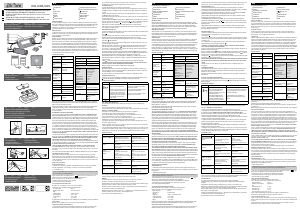


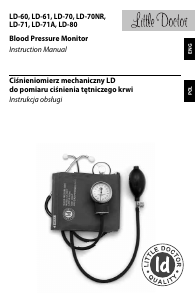
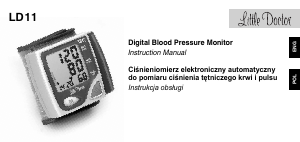
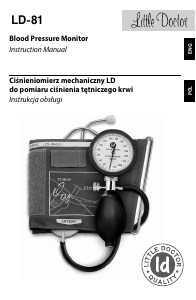
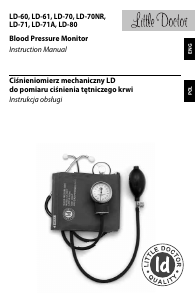
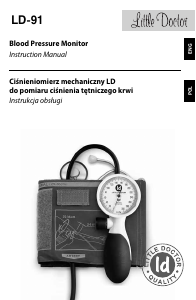
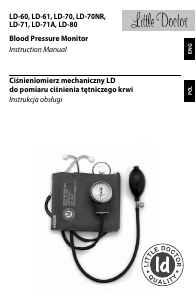
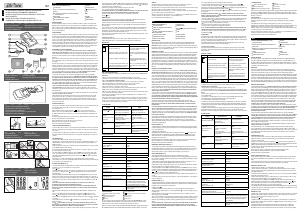
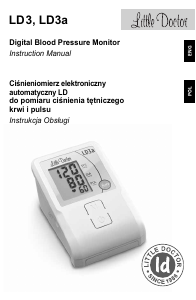
Join the conversation about this product
Here you can share what you think about the Little Doctor LD-23 Blood Pressure Monitor. If you have a question, first carefully read the manual. Requesting a manual can be done by using our contact form.